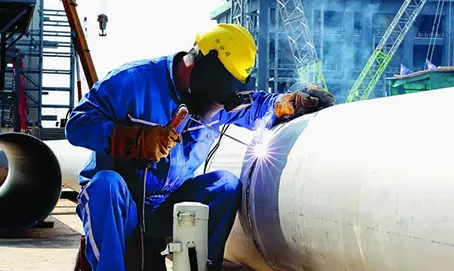Understanding the Basics of Stick Welding Electrode Selection and Application Techniques
Understanding Stick Welding Electrodes Types, Applications, and Selection
Stick welding, also known as Shielded Metal Arc Welding (SMAW), is one of the most widely used welding processes due to its versatility, cost-effectiveness, and ease of use. At the heart of this process lies the stick welding electrode, a fundamental component that plays a critical role in determining the quality and strength of the weld. This article explores the various types of stick welding electrodes, their applications, and tips for selecting the right one.
Types of Stick Welding Electrodes
Stick welding electrodes come in a variety of types, each designed for specific applications and materials
1. E6010 - Deep Penetration Electrodes E6010 electrodes are known for their ability to produce deep penetration welds in various positions. They are ideal for root passes in pipes and are often used in the construction of pipelines. The coating on E6010 electrodes produces a cellulose-based slag, which helps to stabilize the arc and provides good coverage.
2. E6011 - All Position Electrodes Similar to E6010, E6011 electrodes can be used in all positions, including uphill and downhill motions. These electrodes are effective in welding both clean and dirty surfaces, making them suitable for various applications, including maintenance and repair work.
3. E6013 - Versatile and Clean Welding E6013 electrodes are favored for general-purpose welding. They produce a smooth and stable arc with minimal spatter, making them ideal for thin materials and home projects. Their versatility allows them to be used on various materials, including mild steel and certain stainless steels.
4. E7018 - Low Hydrogen Electrodes E7018 electrodes are known for their low hydrogen content, which minimizes the risk of cracking in the weld. These electrodes are ideal for welding structural steel and are often used in critical applications such as bridges and buildings. E7018 can be used in a variety of positions and produces a strong, ductile weld.
5. E7024 - High Deposition Electrodes E7024 electrodes are designed for flat position welding and offer high deposition rates. They are primarily used in heavy fabrication and repairs where speed is crucial. The wide bead produced by E7024 electrodes is effective in providing strong welds on thick sections of steel.
Applications of Stick Welding Electrodes
Stick welding electrodes are widely used across various industries, including fabrication, construction, automotive, and maintenance. Their adaptability makes them suitable for joining different types of metals and alloys. Common applications include
stick welding electrode

- Pipeline Construction Stick welding is essential in constructing and maintaining pipelines, where deep penetration is crucial for ensuring the integrity of the joints. - Building Structures In the construction industry, stick welding is used to join structural components, ensuring safety and durability in buildings and bridges. - Repair Works The versatility of stick electrodes allows them to be employed in repair works, providing reliable and efficient solutions for damaged structures.
Selecting the Right Stick Welding Electrode
Choosing the right stick welding electrode involves considering several factors, including the type of material being welded, the position of the weld, and the specific requirements of the project. Here are some guidelines to follow
1. Material Type Identify the material you are welding. Different electrodes are designed for specific types of metals, such as mild steel, stainless steel, or cast iron.
2. Welding Position Depending on whether you are welding in a flat, horizontal, vertical, or overhead position, some electrodes will perform better than others.
3. Electrode Diameter The diameter of the electrode affects the amount of heat generated and the deposition rate. Thicker electrodes deliver more heat, while thinner ones provide greater control for delicate work.
4. Moisture Content Low hydrogen electrodes, such as E7018, should be stored properly to prevent moisture absorption, which can lead to weld defects.
5. Project Requirements Assess the specific requirements of the project, including strength, ductility, and the appearance of the weld, to select the best electrode type.
Conclusion
Stick welding electrodes are indispensable in the welding process, providing the necessary material to create strong and durable joints. Understanding the various types of electrodes and their applications allows welders to select the appropriate one for their projects, thereby ensuring quality results. By considering factors such as material type, welding position, and project requirements, welders can enhance their skills and produce high-quality welds that stand the test of time.
-
Premium Solid MIG Welding Wire - Strong, Low-Spatter WeldsNewsJul.21,2025
-
E71T-GS Self-Shielding Welding Wire | Gasless Outdoor UseNewsJul.20,2025
-
E312 Welding Electrode - High Corrosion Resistance & All-Purpose UseNewsJul.20,2025
-
Best MIG Welding No Gas Flux Core Solution – Easy, Portable & Clean WeldingNewsJul.08,2025
-
7018 Welding Rod 3/16 - High Strength, Low Hydrogen Electrodes Wholesale 3/32 Welding Rod 7018 Suppliers & China 7018 AC Welding Rod FactoryNewsJul.08,2025
-
High Quality MIG Aluminium Welding Wire - Wholesale Factory Prices from China SuppliersNewsJul.07,2025


